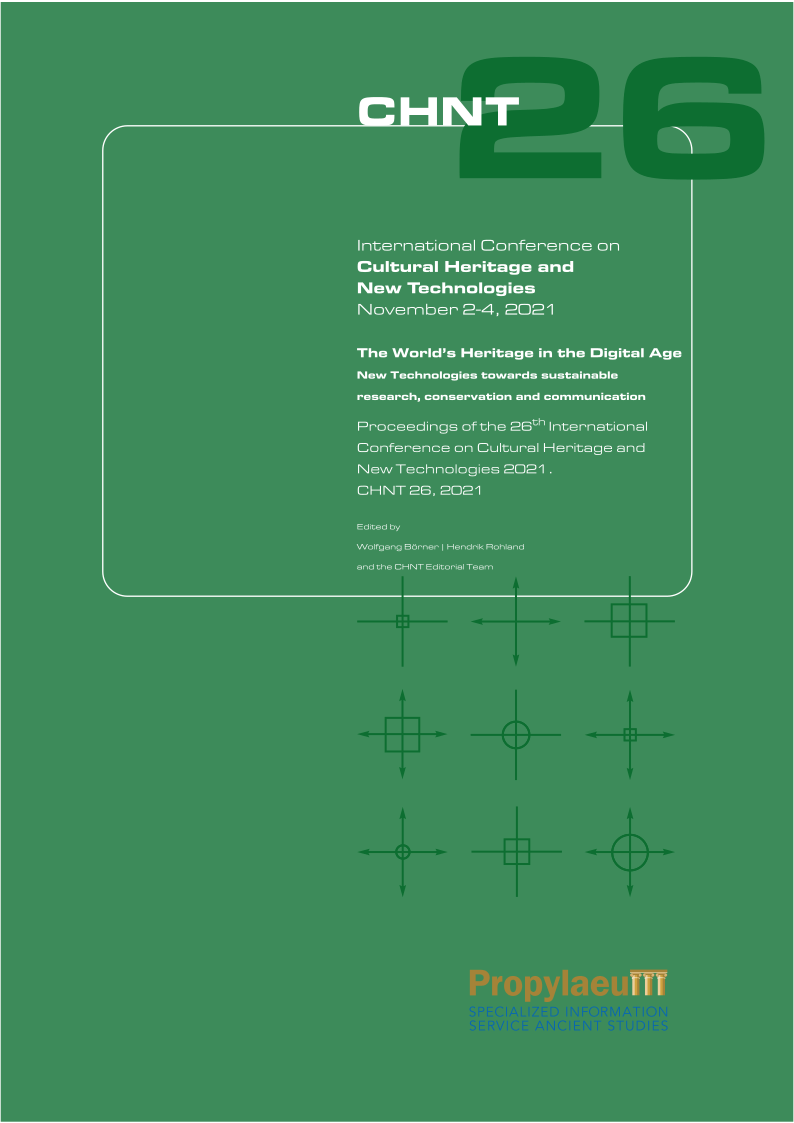Challenges faced in documentation and publication of 3D reconstructions of Cultural Heritage
How to capture the process and share the data?
Keywords:
3d models, documentation, web-publication, metadata scheme, source-based 3D reconstructionAbstract
This paper presents significant challenges in documenting and publishing source-based hypothetical 3D reconstruction of Cultural Heritage (CH). The authors focus on the lack of standardized procedures, difficulties in data sharing due to diverse file formats, and technological limitations in web-based model viewing. They highlight the role of key guiding documents, namely the London Charter (LC) and the Seville Principles (SP), which outline principles for computer-based visualization and virtual archaeology. While these documents emphasize the need for documenting uncertainties, sources, authenticity, and historical rigor in 3D reconstructions, they lack detailed practical implementation guidelines. This gap has led to varied documentation approaches in related fields such as archaeology and architectural history. The authors also discuss principles for the publication of data, including FAIR Principles and the 5-Star Open Data Scheme introduced by Time-Berners Lee. Three main methods of documentation, namely the Knowledge Graph, Reconstruction-Argumentation-Method (R-A-M) and web-based visualization, are examined. Each of these methods offers different advantages and meets varying principles of LC and SP. Three publication methods based on the virtual research environment (VRE), using SciDoc, an institutional repository for documentation of digital reconstruction projects, and Sketchfab, a commercial repository for 3D models, are also discussed. The paper concludes with a presentation of the DFG 3D-Viewer, an infrastructure project for the publication of digital reconstructions and a proposal for a basic metadata schema. The shared metadata schema is a first step towards developing methods for archiving 3D models. The authors also advocate for collaborative efforts among stakeholders and funding institutions to develop standard, comprehensive solutions for preserving digital reconstructions of CH.
References
Bajena, I. and Kuroczyński, P. (2023). Development of the methodology and infrastructure for digital 3D reconstruction. In: AMPS PROCEEDINGS SERIES 29.2, (IN)TANGIBLE HERITAGE(S): Design, culture and technology – past, present, and future. AMPS, Canterbury, pp.72-83, Available at: https://tiny.pl/w26jp (Accessed 08 March 2023).
Bajena, I. and Kuroczyński, P. (2023a). Metadata for 3D Digital Heritage Models. In the Search of a Common Ground. In: Münster, S., Pattee, A., Kröber, C., Niebling, F. (eds) Research and Education in Urban History in the Age of Digital Li-braries. UHDL 2023. Communications in Computer and Information Science, vol 1853. Springer, Cham. https://doi.org/10.1007/978-3-031-38871-2_4.
Berners-Lee, T. (2006) Linked Data, W3C - Design Issues, pp. 2–6. Available at: https://www.w3.org/DesignIssues/LinkedData.html (Accessed: 24 January 2022).
Berners-Lee, T. (2012). Five Star Open Data. Available at https://5stardata.info/en/ (Accessed 29 January 2022).
Candela, L., Castelli, D. and Pagano, P. (2013). Virtual Research Environments: An Overview and a Research Agenda, Da-ta Science Journal. 12. DOI: 10.2481/dsj.GRDI-013
Champion, E., Rahaman, H. (2020). Survey of 3D digital heritage repositories and platform. Virtual Archaeology Review. 11(23):1. DOI: 10.4995/var.2020.13226
CIDOC CRM Special Interest Group (2021).Definition of the CIDOC Conceptual Reference Model version 7.2. Available at: https://www.cidoc-crm.org/versions-of-the-cidoc-crm (Accessed 23 January 2022).
Flynn, T. (2019) Sketchfab Cultural Heritage User Survey 2019 Results. Available at: https://sketchfab.com/blogs/community/over-100000-cultural-heritage-3d-models-on-sketchfab (Accessed 23 January 2023).
Grellert, M., Apollonio, F.I., Martens, B. and Nußbaum. N. (2019). Working Experiences with the Reconstruction Argumenta-tion Method (RAM) – Scientific Documentation for Virtual Reconstruction, Proceedings of the 23rd International Confer-ence on Cultural Heritage and New Technologies 2018, Vienna, 14 pages. Available at: http://www.chnt.at/proceedings-chnt-23/ (Accessed 29 January 2022)
Gutierrez, C. and Sequeda, J.F. (2021). Knowledge graphs. Commun. ACM 64, 3 (March 2021), 96–104. https://doi.org/10.1145/3418294
Kiryakov A., (2015). Triplestores are Proven as Operational Graph Databases. Available at: https://www.ontotext.com/blog/triplestores-are-proven-as-operational-graph-databases/ (Accessed 16 December 2023).
Kuroczyński, P. (2017). Virtual Research Environment for Digital 3D Reconstructions – Standards, Thresholds and Pro-spects, Studies in Digital Heritage 1( 2), pp. 456–476. DOI: 10.14434/sdh.v1i2.23330
Kuroczyński P., Bajena I. P., Große P., Jara K., and Wnęk K. (2021). Digital Reconstruction of the New Synagogue in Bres-lau: New Approaches to Object-Oriented Research. In: Niebling F., Münster S., Messemer H. (eds) Research and Edu-cation in Urban History in the Age of Digital Libraries. UHDL 2019. Communications in Computer and Information Sci-ence, vol 1501. Springer, Cham. DOI: 10.1007/978-3-030-93186-5_2
Kuroczyński P. and Große P. (2020). OntSciDoc3D – Ontology for Scientific Documentation of source-based 3D recon-struction of architecture. In: CHNT 25, Abstracts. Available at: https://www.chnt.at/wp-content/uploads/OntSciDoc3D-%E2%80%93-Ontology-for-Scientific-Documentation-of-source-based-3D-reconstruction-of-architecture.pdf (Accessed 26 January 2022).
The London Charter (2009). Available at https://londoncharter.org/index.html (Accessed 23 January 2022).
The Seville Principles (2017). Available at http://sevilleprinciples.com/ (Accessed 23 January 2022).
Wilkinson, M., Dumontier, M. and Aalbersberg, I., et al. (2016). The FAIR Guiding Principles for scientific data management and stewardship. In: Sci Data 3, 160018 DOI: 10.1038/sdata.2016.18
Downloads
Published
Conference Proceedings Volume
Section
License
Copyright (c) 2025 Igor Piotr Bajena, Prof. Dr.-Ing. Piotr Kuroczyński

This work is licensed under a Creative Commons Attribution-ShareAlike 4.0 International License.
The CHNT older Proceedings are licensed under the creative commons license CC BY-NC-ND 3.0.
From the issue 26 on, they will be licensed under the creative commons license CC-BY-SA 4.0


